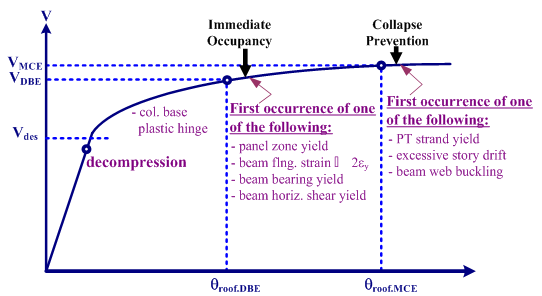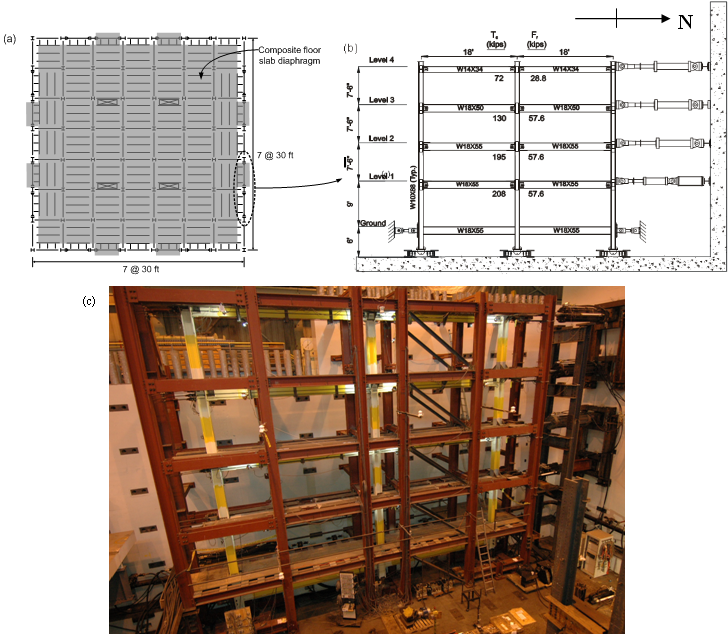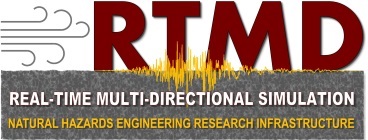Self-Centering Damage-Free Seismic-Resistant Steel Frame Systems (Moment Resisting Frame)
Objectives
The overall project objective is to investigate a family of innovative self-centering (SC) steel frame systems with the potential to withstand the currently accepted design basis earthquake (DBE) for buildings without damage. This current project task is focusing on the design and experimental performance of a self-centering moment-resisting frame (SC-MRF). The SC-MRF test structure was designed using limit-state based design criteria to be undamaged under a median-level DBE and undergo controlled yielding under the Maximum Considered Earthquake (MCE). This expected performance will be assessed and the design criteria verified through hybrid-pseudo-dynamic experiments on a 0.6-scale 2-bay 4-story SC-MRF.
Earthquake Simulations
1. Introduction
The SC-MRF is a post-tensioned MRF with web friction devices (WFDs) as energy dissipating devices. The WFDs are positioned on the beam web to avoid interference with the floor slab. Using a performance based design (PBD) approach the SC-MRF is designed to be damage-free under the DBE to enable immediate occupancy, while also achieving the performance level of collapse prevention under the MCE. Figure 1(a) shows an SC-MRF with WFDs. The PT strands run parallel to the beams across multiple bays to precompress the beams to the columns. The WFDs are shown in more detail in Figure 1(b) and (c).
2. Experimental Program
Using the specific design criteria and the performance-based design (PBD) approach shown in Figure 2, a 7×7-bay 4-story prototype building shown in Figure 3(a) was designed. The building is located on stiff soil in the Los Angeles. The perimeter frames include SC-MRFs. Each perimeter frame has two 2-bay SC-MRFs with WFDs. Figure 3(a) also shows the floor diaphragm is attached to one bay of each SC-MRF in each perimeter frame to avoid restraining the post-tensioned connections from developing gap opening.
2.1. Test Structure, Test Setup and Test Matrix
The test structure for the experimental program is a 0.6-scale 4-story 2-bay SC-MRF as shown in Figure 3(b). A992 steel sections were used throughout the test structure. Figure (c) shows the test structure. The Table 1 summarizes the design demands for roof drift (θroof), story drift (θs), and connection relative rotation (θr) under the DBE and MCE levels. The hybrid pseudo-dynamic simulation uses an analytical model for the gravity load-carrying system of the building, along with the test structure in the laboratory. The simulation uses Rayleigh damping with 2% damping in the 1st mode and 5% in the 3rd mode. The explicit unconditionally stable CR integration algorithm is used to solve the equations of motion. The test matrix is shown in Table 1.
3. Related Publications
4. Participants
Graduate Research Assistant
- Ying-Cheng Lin
Faculty Advisors
- Richard Sause
- James Ricles
Post-Doctoral Research Associates
- Choung-Yeol Seo
Table 1 – Design demands (in radians)
| θroof,DBE | θs,DBE | θr,DBE | θroof,MCE | θs,MCE | θr,MCE |
|---|---|---|---|---|---|
| 0.026 | 0.039 | 0.031 | 0.039 | 0.059 | 0.047 |
Table 2 – Test matrix
| Tests | Description | Ground Motion Record | Scale Factor | Test Method |
|---|---|---|---|---|
| Stiffness | Stiffness matrix determination | — | — | Static |
| Pushover | WFD connection behavior check | — | — | Static |
| FOE-1 | 1979 Imperial Valley | H-CXO225 | 0.700 | Pseudo-dynamic |
| FOE-2 | 1979 Imperial Valley | H-CXO225 | 1.410 | |
| DBE-1 | 1979 Imperial Valley | H-ECC002 | 0.943 | |
| DBE-2 | 1989 Loma Prieta | SJTE315 | -2.234 | |
| DBE-3 | 1994 Northridge | LOS000 | 1.182 | |
| MCE | 1994 Northridge | STM090 | 2.071 | |
| Aftershock | 1979 Loma Prieta | SJTE315 | -2.234 |
 Figure 1 – Schematic of (a) Elevation of a 2-bay SC-MRF with PT strands and WFDs, (b) and (C) Connection details
Figure 1 – Schematic of (a) Elevation of a 2-bay SC-MRF with PT strands and WFDs, (b) and (C) Connection details

Figure 2 – Performance based design objectives

Figure 3 – Schematic of (a) Plan of prototype, (b) Elevation of 0.6-scale 4-story 2-bay SC-MRF test frame, and (c) Experimental test frame (the yellow frame).


